Planning policy - section 3F: research
Report commissioned to help develop a Scotland wide Section 3F planning policy, by proposing reasonable levels of CO2 (Carbon dioxide) emissions reduction that can be expected from use of low and zero carbon generating technologies (LZCGTs) in new buildings.
Appendix C: Compliance Calculations
The figures included in Appendix C are screenshots of proposed standardised compliance calculations. For stakeholder familiarity these have been generated in Microsoft Excel.
Proposal 1: Compliance Calculation Spreadsheet
The compliance calculation spreadsheet for Proposal 1 consists of two worksheets. The first is a Data Input sheet where applicants simply record the type of LZCGT employed in the building and input the four values used in the calculation formula: the percentage CO2 emission reduction sought by Scottish Building Standards for the building type (R%), the target emission rate (TER), the dwelling/building emission rate (DER or BER) and the dwelling/building emission rate calculated without the specified LZCGT (DERNT or BERNT) (Figure C.1). The second is the Compliance Calculation sheet, which simply substitutes the input data into the compliance formula to calculate the contribution LZCGT makes to the CO2 emission reductions and then delivers a clear statement as to whether the building is in compliance with Section 3F policy (Figure C.2).
Data Input
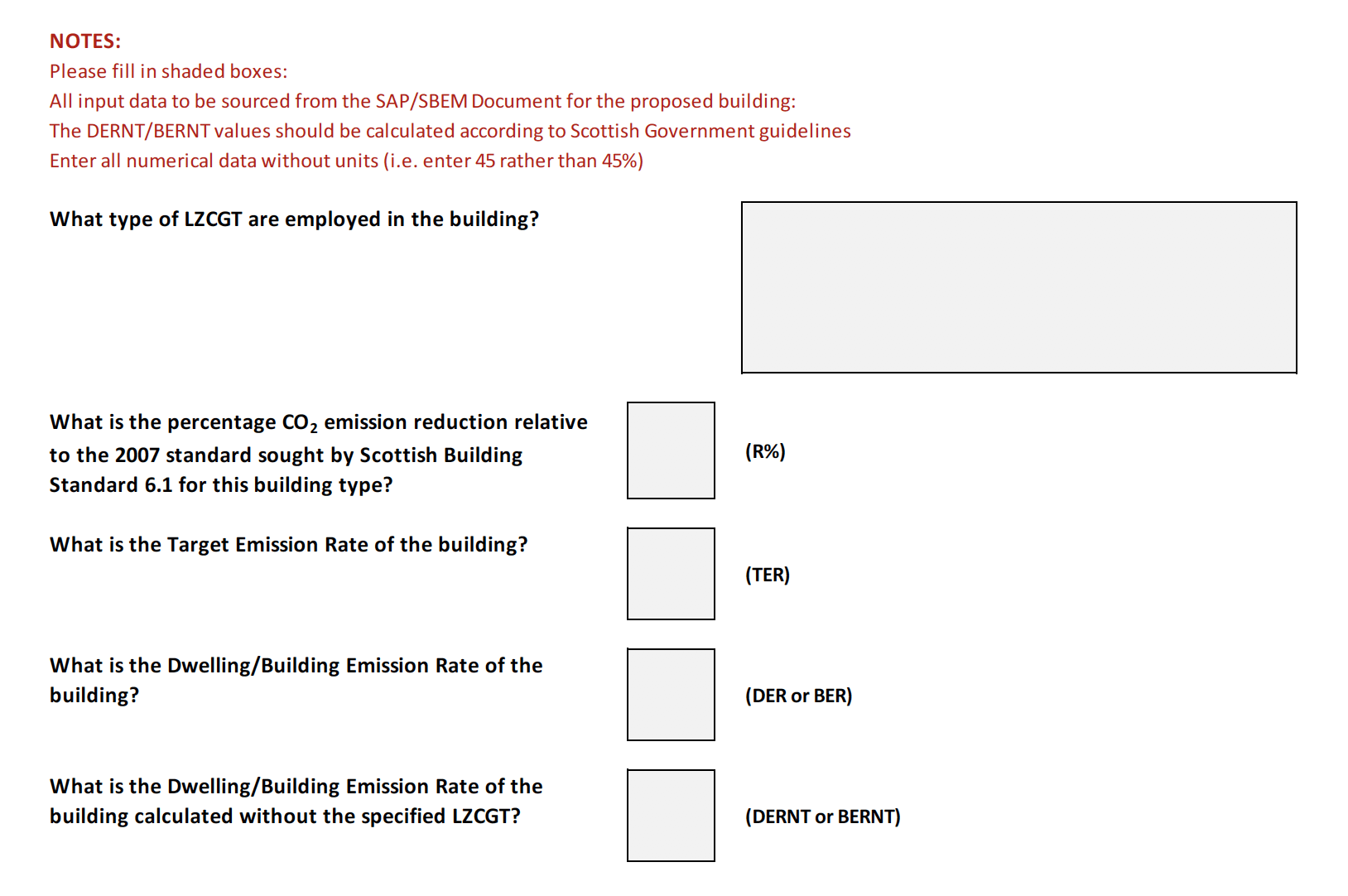
Compliance Calculation

Proposal 2: Compliance Calculation Spreadsheet & Worked Examples
The compliance spreadsheet for Proposal 2 is split into two sections; Section 1 is to be completed for dwellings that have individual energy systems and micro-CHP (Figures C.3 and C.4), Section 2 for those with community heating systems (Figures C.5 and C.6). Each Section is sub-divided into a Data Input sheet and a Compliance Calculation sheet.
To use the spreadsheet, the applicant simply extracts relevant data from the DER worksheet of the SAP calculation for the proposed dwelling, and inputs this into the appropriate Data Input worksheet. SAP box numbers are clearly indicated for guidance. Excel completes all necessary calculations automatically on the Compliance Calculation worksheet, and displays both a clear statement of policy compliance/non-compliance and a breakdown of the contribution of individual energy systems and LZCGT which are characterised as zero-carbon, low-carbon, grid electricity, bio-carbon or fossil fuel. Only zero-carbon energy sources are used to mitigate annual energy demand (AED). The whole process should take no more than 10 minutes.
Three worked examples are also included, to illustrate the methodology (Table C.1). All three buildings were designed between 2012 and 2014, and were part of the data set described in Appendix E.
| Worked Example 1 (Figures C.7, C.8) | Worked Example 2 (Figures C.9, C.10) | Worked Example 3 (Figures C.11, C.12) | |
|---|---|---|---|
| Description: | |||
| Context | Suburban | Urban | Remote Rural |
| Building Type | Detached Passivhaus | Mid-Terrace Flat | Detached House |
| Area | 255m2 | 66m2 | 182m2 |
| Main Heating System | ASHP | GAS | ASHP |
| Secondary Heating System | Biomass | ||
| Zero-Carbon Energy sources | ASHP PV MVHR | MVHR | ASHP Solar Thermal MVHR |
| Energy Demands: | |||
| AED | 7,372 kWh/annum | 3,587 kWh/annum | 7,636 kWh/annum |
| ZCAED | 1,674 kWh/annum | 3,587 kWh/annum | 4,469 kWh/annum |
| Compliance: | |||
| 2021AAED | 5,870 kWh/annum | 4,117 kWh/annum | 5,689 kWh/annum |
| 2021AAED Compliant | YES (Method 2) | YES (Method 1) | YES (Method 2) |
| 2024AAED | 4,610 kWh/annum | 3,233 kWh/annum | 4,467 kWh/annum |
| 2024AAED Compliant | YES (Method 2) | NO | NO |
Section 1: Data Input Sheet
Notes:
Please fill in all relevant shaded boxes:
All input data to be sourced from the SAP 2012 Document DER worksheet for the proposed building:
Use the SAP box numbers and System / Fuel Codes indicated:
The convention in SAP data is to indicate Energy Demands as positive values; and Energy Generation as negative values.
1 The boxes marked are usually recorded as negative values
2 For Pumps & Fans: If associated with a specific building system use that System Code, if not use Grid Electricity (E)
Individual Energy Systems & Micro-CHP
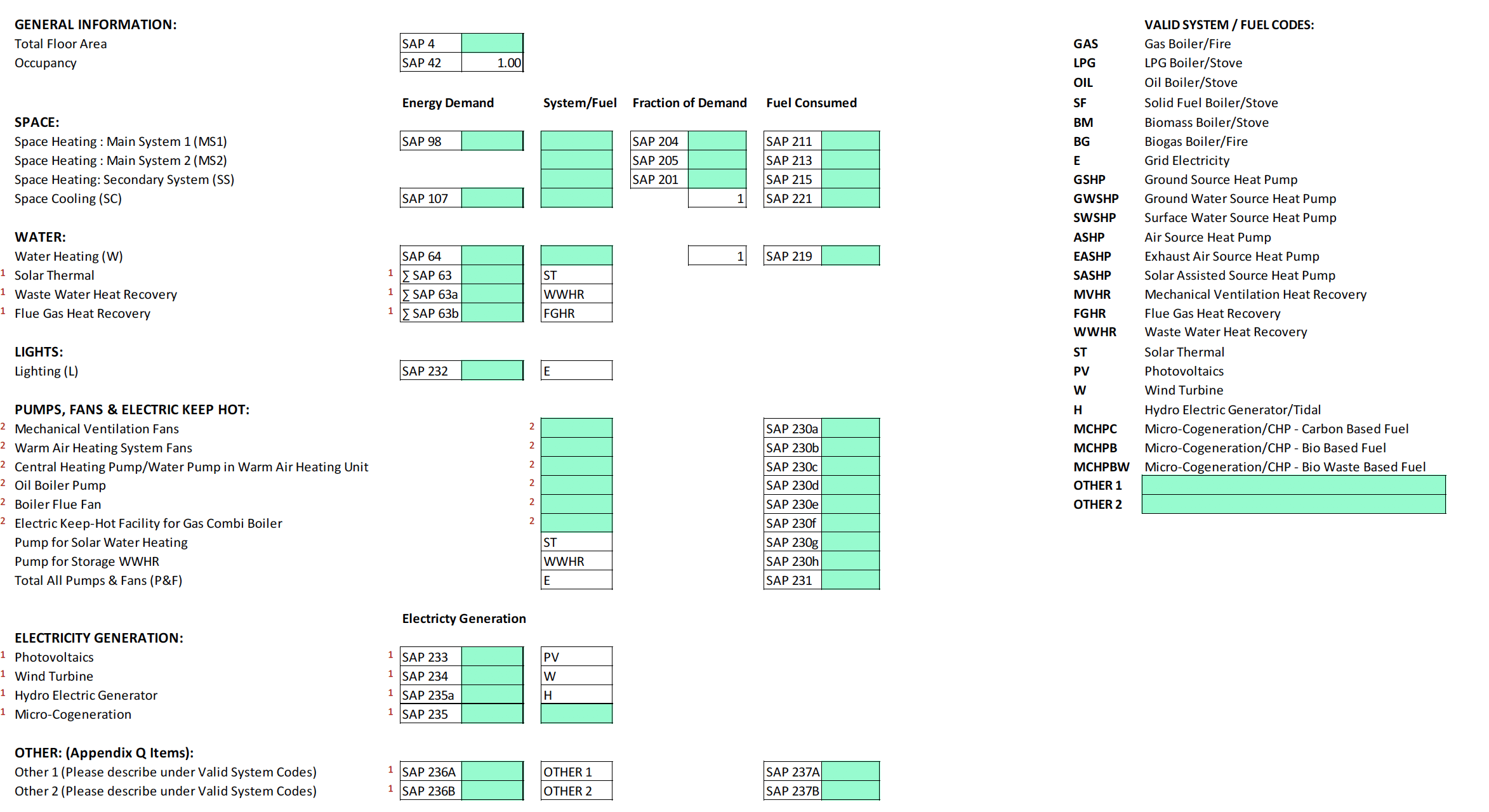

Section 1: Breakdown Of Contribution Of Individual Energy Sources & LZCGT
Notes:
The convention in SAP data is to indicate Energy Demands as positive values; and Energy Generation as negative values.
Only Zero-Carbon Generation is used to calculate ZCAED.
1 The contributions of Solar Thermal, WWHR, FGHR & MVHR are already embedded within the AED so are excluded from the calculation of ZCAED
2 The Grid Electricity consumed by Pumps, Fans and Electric Keep Hot (Not including that used in Heat Pumps) is already embedded within the AED so is excluded from the calculation of Zero-Carbon & Low Carbon Contribut
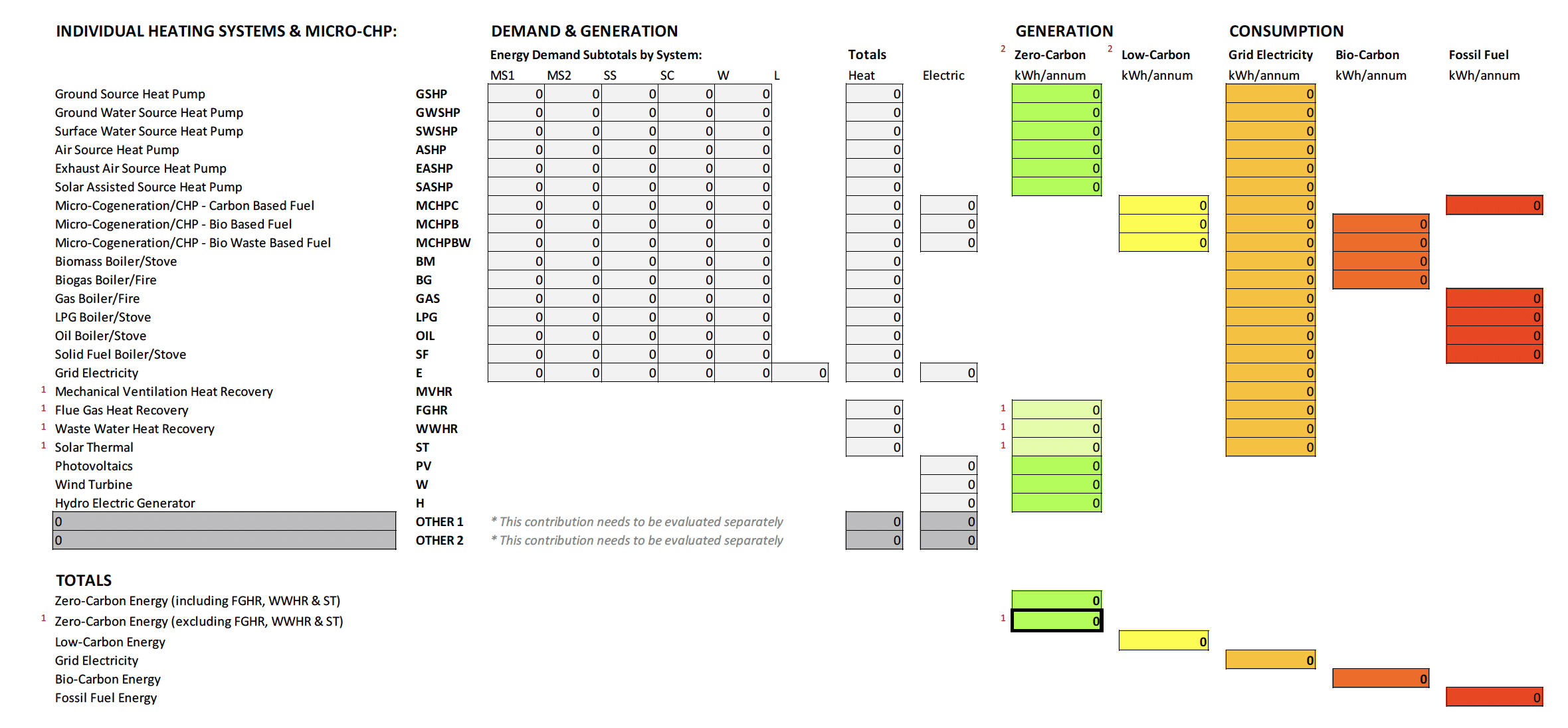
Section 2: Data Input Sheet
Notes:
Please fill in all relevant shaded boxes:
All input data to be sourced from the SAP 2012 Document DER worksheet for the proposed building:
Use the SAP box numbers and System / Fuel Codes indicated:
The convention in SAP data is to indicate Energy Demands as positive values; and Energy Generation as negative values.
1 The boxes marked are usually recorded as negative values
2 For Pumps & Fans: If associated with a specific building system use that System Code, if not use Grid Electricity (E)
Community Heating
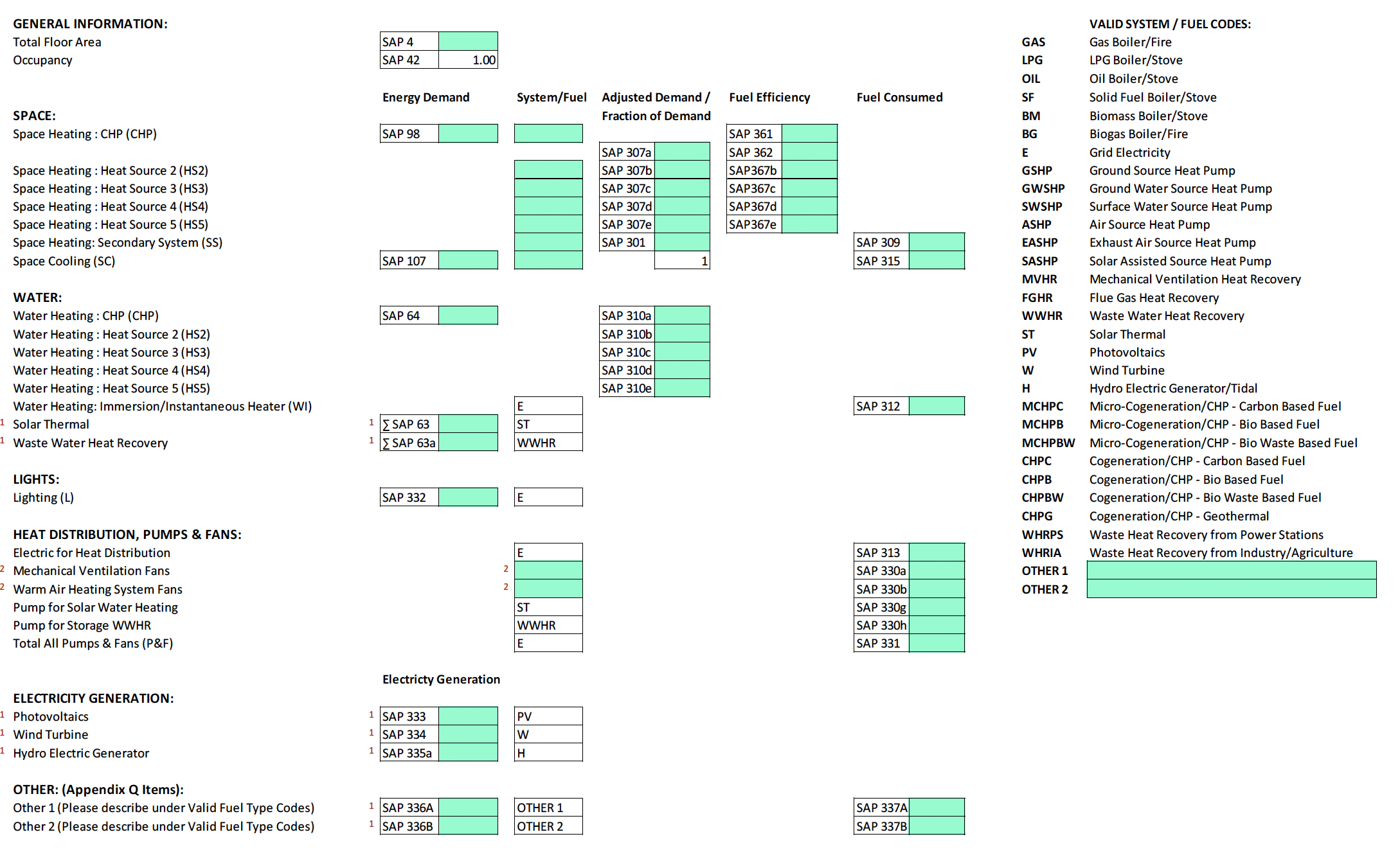
Section 2: Breakdown Of Contribution Of Individual Energy Sources & LZCGT

Notes:
The convention in SAP data is to indicate Energy Demands as positive values; and Energy Generation as negative values.
Only Zero-Carbon Generation is used to calculate ZCAED.
1 The contributions of Solar Thermal, WWHR & MVHR are already embedded within the AED so are excluded from the calculation of ZCAED
2 The Grid Electricity consumed by Heat Distribution, Pumps and Fans (NOT including that used in Heat Pumps) is already embedded within the AED so is excluded from the calculation of Zero-Carbon & Low Carbon Contribution
3 For simplicaity the grid electricity consumed in Heat Distribution is recorded under Grid Electricity rather than subdivided between each of the contributing power sources
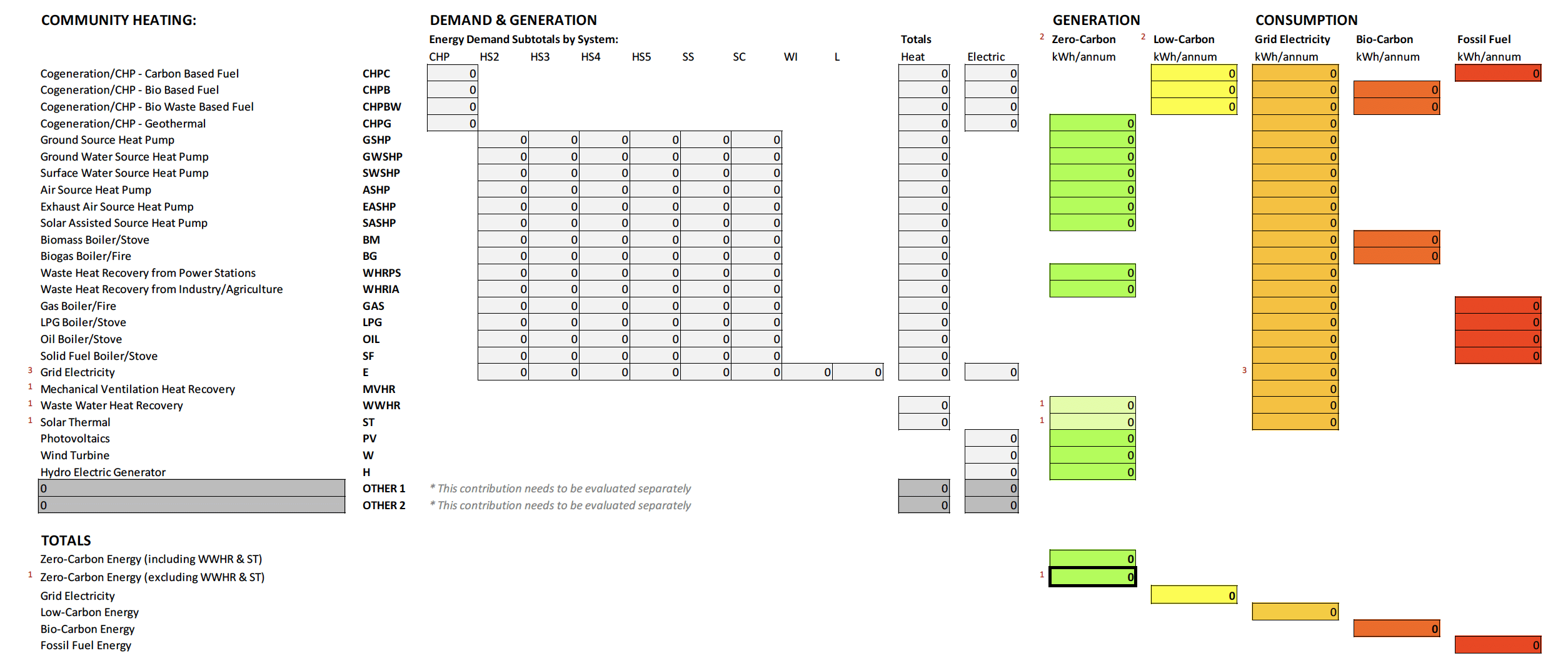
Section 1: Data Input Sheet
Notes:
Please fill in all relevant shaded boxes:
All input data to be sourced from the SAP 2012 Document DER worksheet for the proposed building:
Use the SAP box numbers and System / Fuel Codes indicated:
The convention in SAP data is to indicate Energy Demands as positive values; and Energy Generation as negative values.
1 The boxes marked are usually recorded as negative values
2 For Pumps & Fans: If associated with a specific building system use that System Code, if not use Grid Electricity (E)
Individual Energy Systems & Micro-CHP
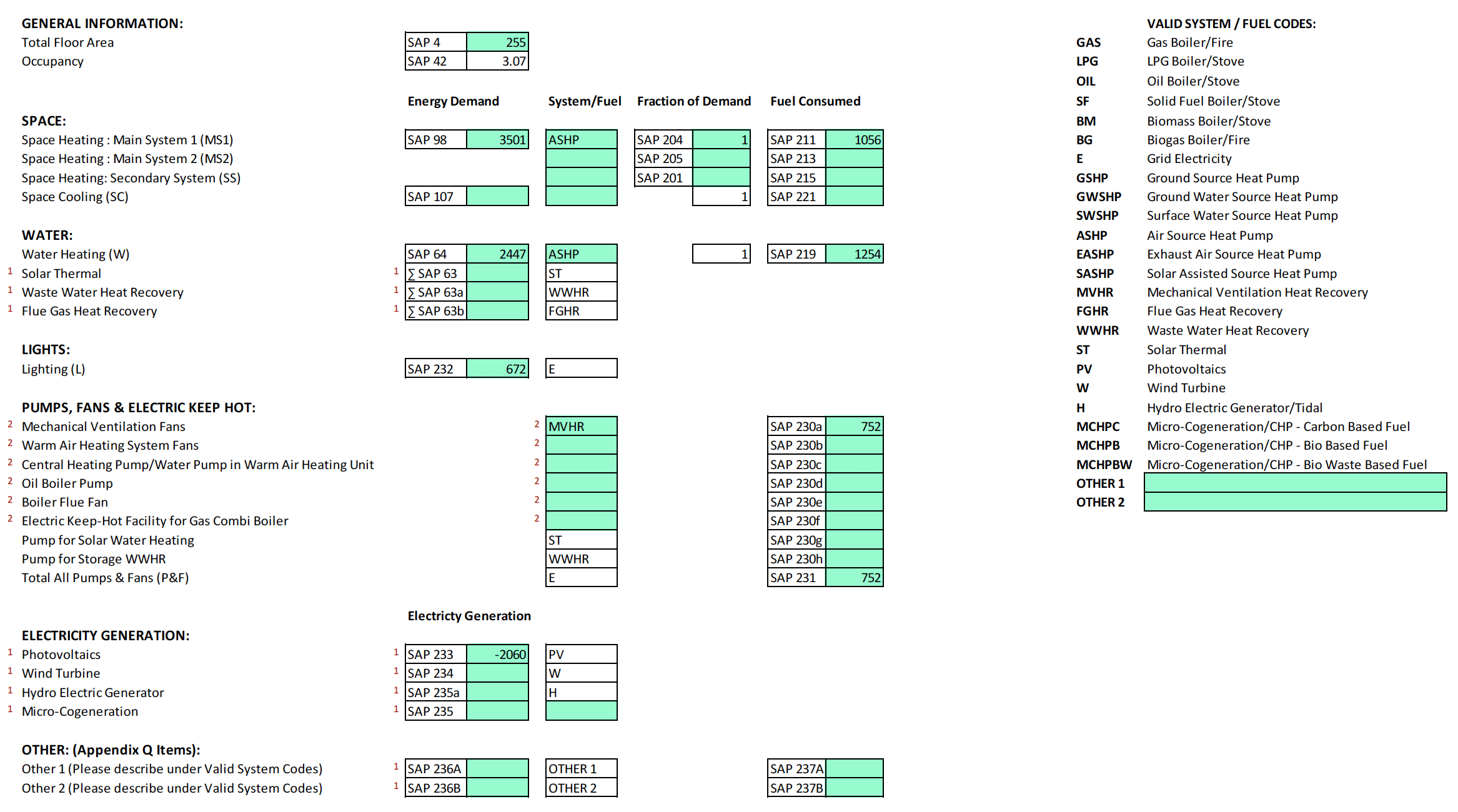

Section 1: Breakdown Of Contribution Of Individual Energy Sources & LZCGT
Notes:
The convention in SAP data is to indicate Energy Demands as positive values; and Energy Generation as negative values.
Only Zero-Carbon Generation is used to calculate ZCAED.
1 The contributions of Solar Thermal, WWHR, FGHR & MVHR are already embedded within the AED so are excluded from the calculation of ZCAED
2 The Grid Electricity consumed by Pumps, Fans and Electric Keep Hot (Not including that used in Heat Pumps) is already embedded within the AED so is excluded from the calculation of Zero-Carbon & Low Carbon Contribution
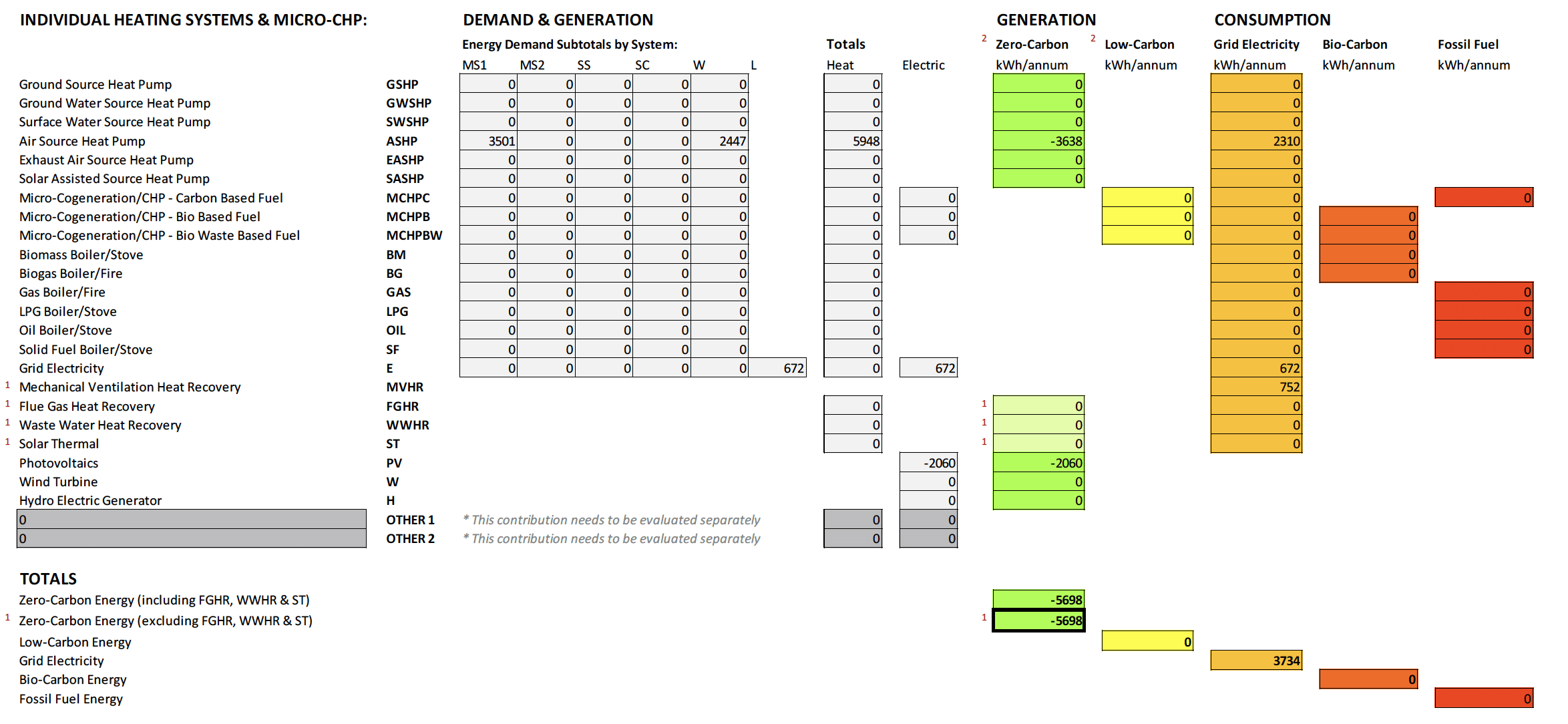
Section 1: Data Input Sheet
Notes:
Please fill in all relevant shaded boxes:
All input data to be sourced from the SAP 2012 Document DER worksheet for the proposed building:
Use the SAP box numbers and System / Fuel Codes indicated:
The convention in SAP data is to indicate Energy Demands as positive values; and Energy Generation as negative values.
1 The boxes marked are usually recorded as negative values
2 For Pumps & Fans: If associated with a specific building system use that System Code, if not use Grid Electricity (E)
Individual Energy Systems & Micro-CHP
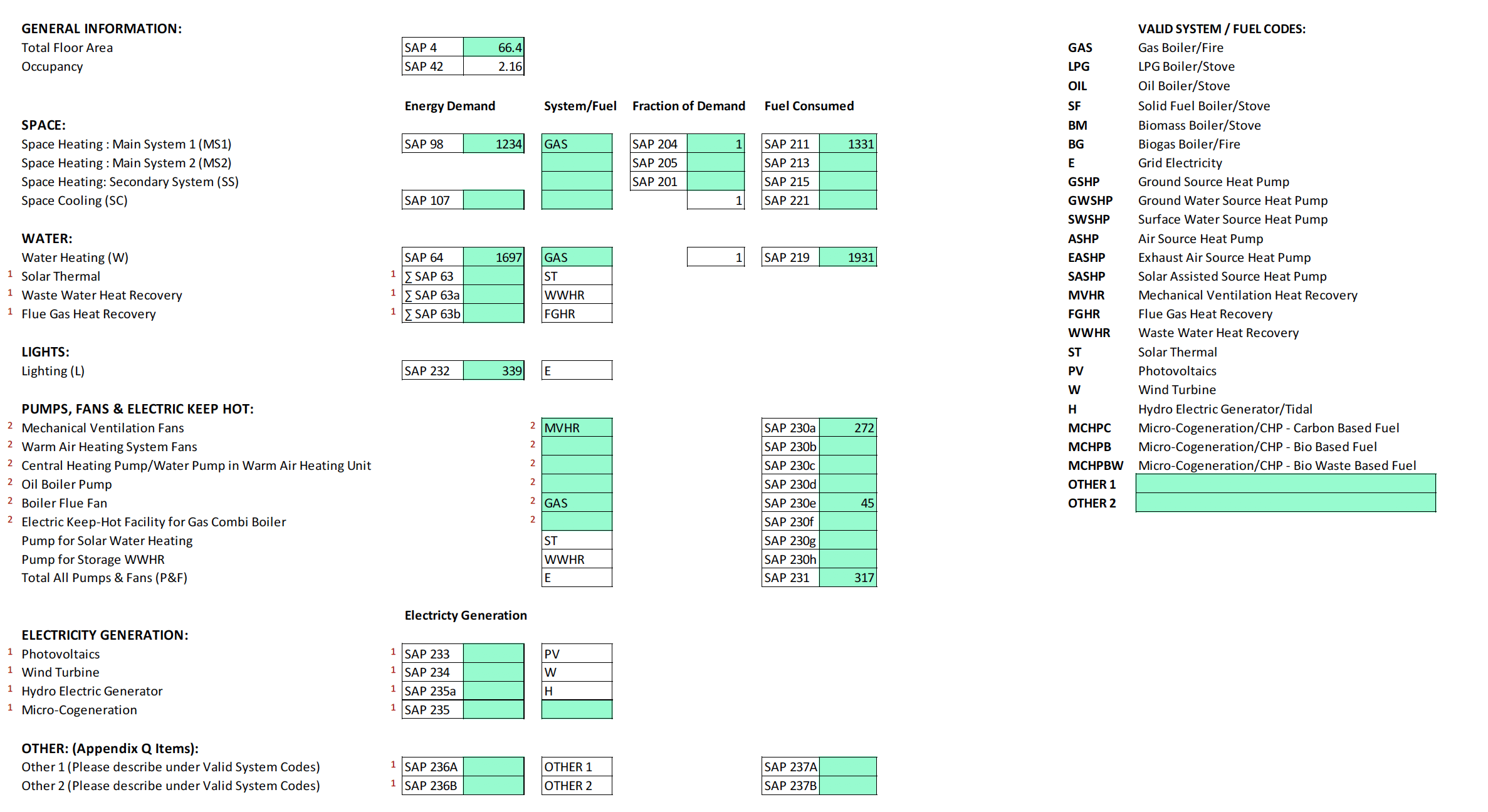

Section 1: Breakdown Of Contribution Of Individual Energy Sources & LZCGT
Notes:
The convention in SAP data is to indicate Energy Demands as positive values; and Energy Generation as negative values.
Only Zero-Carbon Generation is used to calculate ZCAED.
1 The contributions of Solar Thermal, WWHR, FGHR & MVHR are already embedded within the AED so are excluded from the calculation of ZCAED
2 The Grid Electricity consumed by Pumps, Fans and Electric Keep Hot (Not including that used in Heat Pumps) is already embedded within the AED so is excluded from the calculation of Zero-Carbon & Low Carbon Contribution
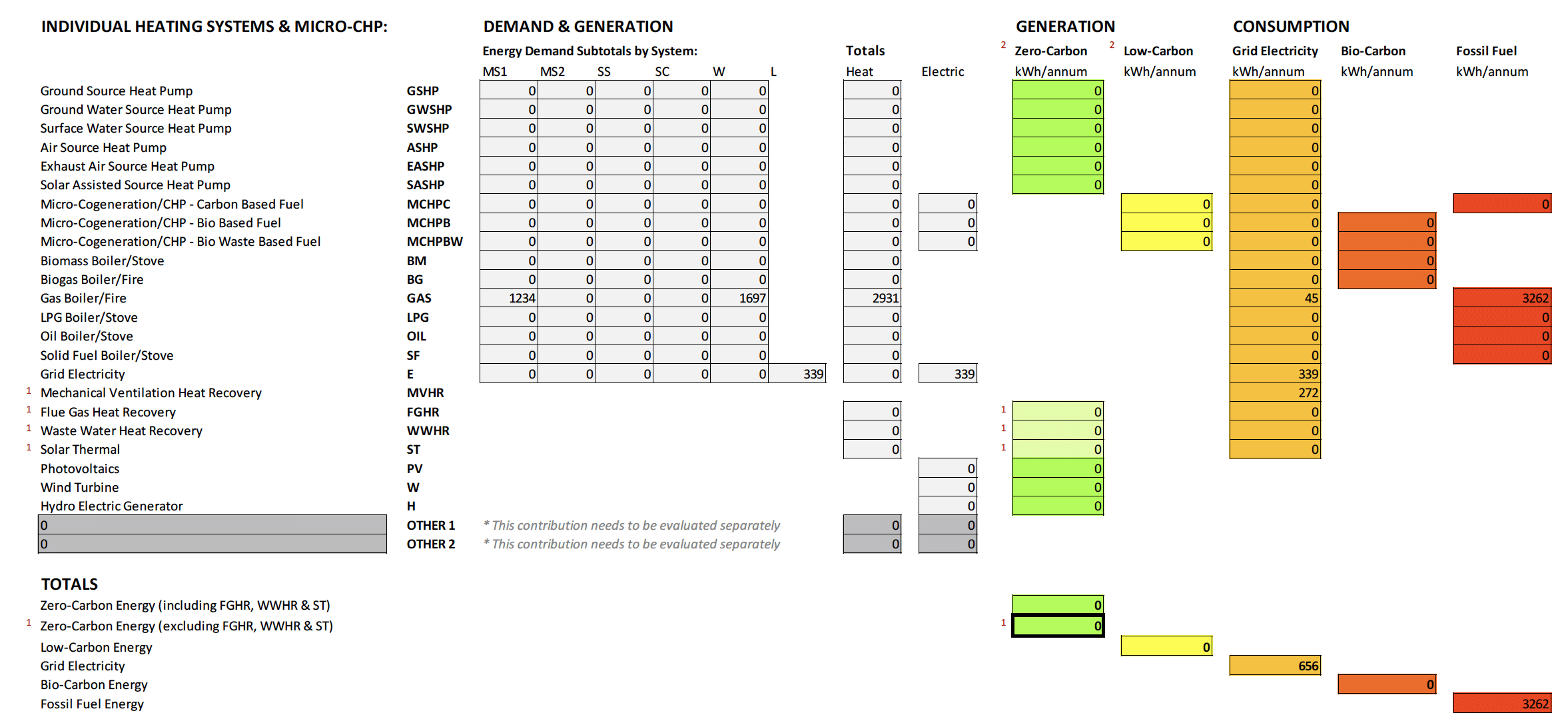
Section 1: Data Input Sheet
Notes:
Please fill in all relevant shaded boxes:
All input data to be sourced from the SAP 2012 Document DER worksheet for the proposed building:
Use the SAP box numbers and System / Fuel Codes indicated:
The convention in SAP data is to indicate Energy Demands as positive values; and Energy Generation as negative values.
1 The boxes marked are usually recorded as negative values
2 For Pumps & Fans: If associated with a specific building system use that System Code, if not use Grid Electricity (E)
Individual Energy Systems & Micro-CHP
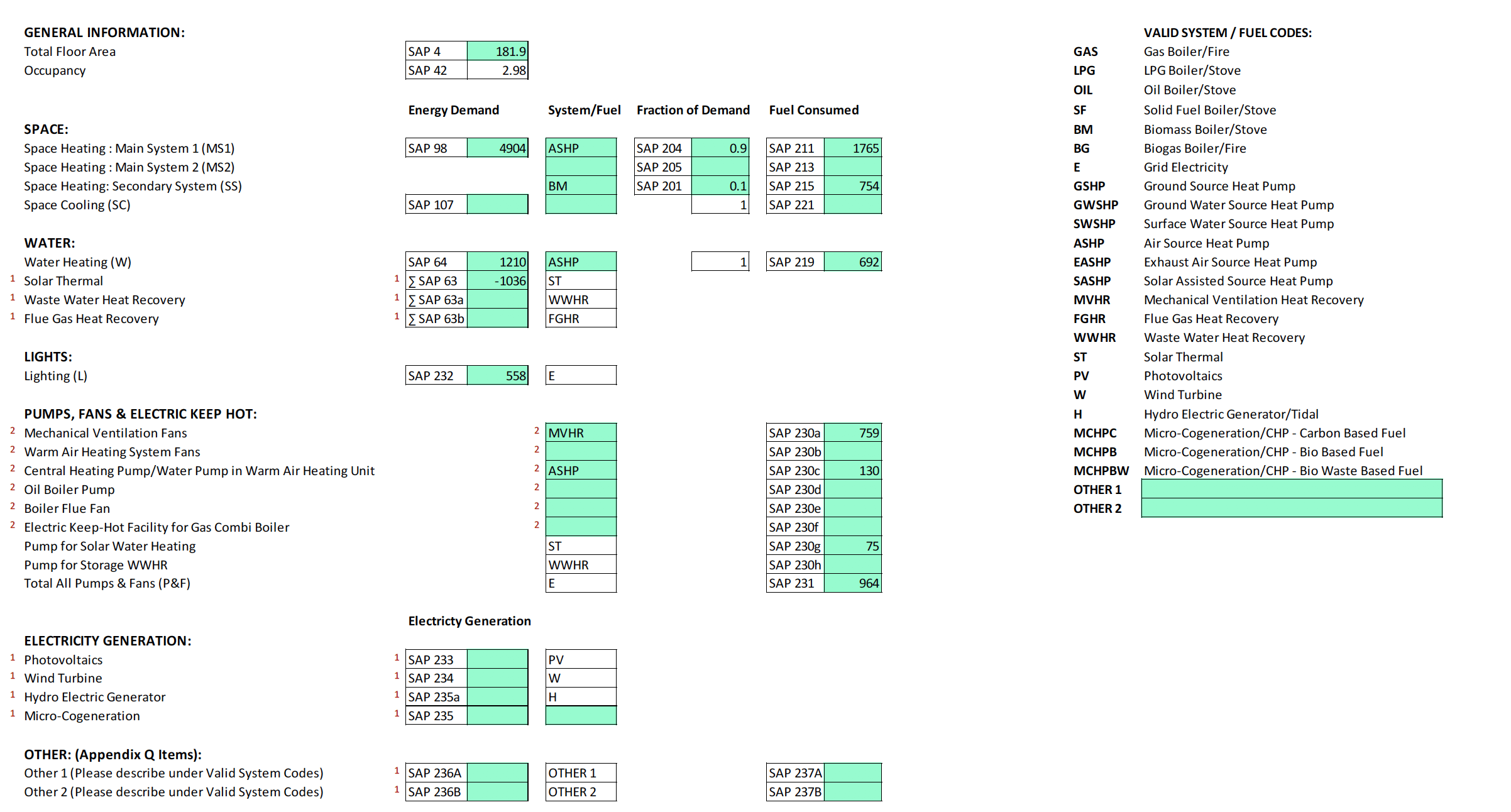

Section 1: Breakdown Of Contribution Of Individual Energy Sources & LZCGT
Notes:
The convention in SAP data is to indicate Energy Demands as positive values; and Energy Generation as negative values.
Only Zero-Carbon Generation is used to calculate ZCAED.
1 The contributions of Solar Thermal, WWHR, FGHR & MVHR are already embedded within the AED so are excluded from the calculation of ZCAED
2 The Grid Electricity consumed by Pumps, Fans and Electric Keep Hot (Not including that used in Heat Pumps) is already embedded within the AED so is excluded from the calculation of Zero-Carbon & Low Carbon Contribution
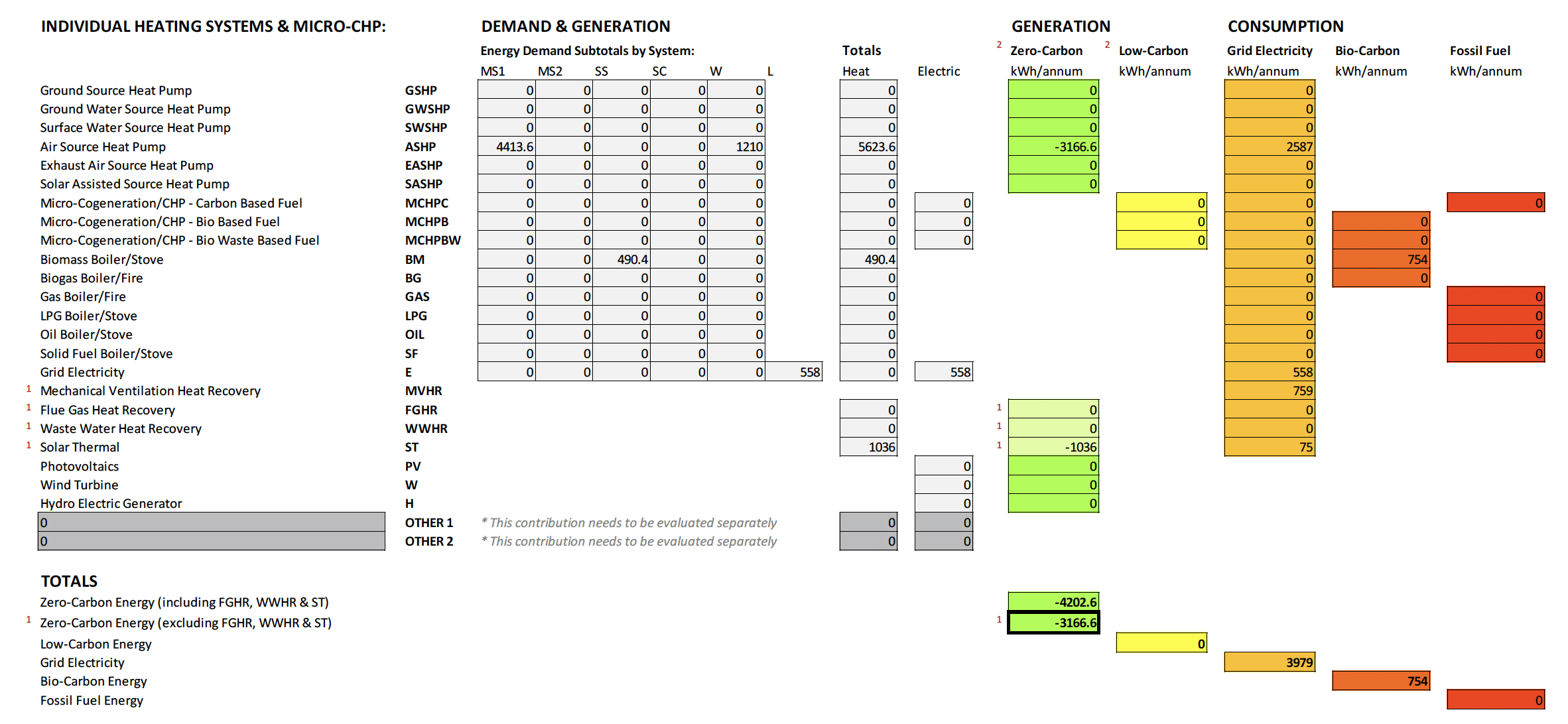
Contact
Email: chief.planner@gov.scot
There is a problem
Thanks for your feedback